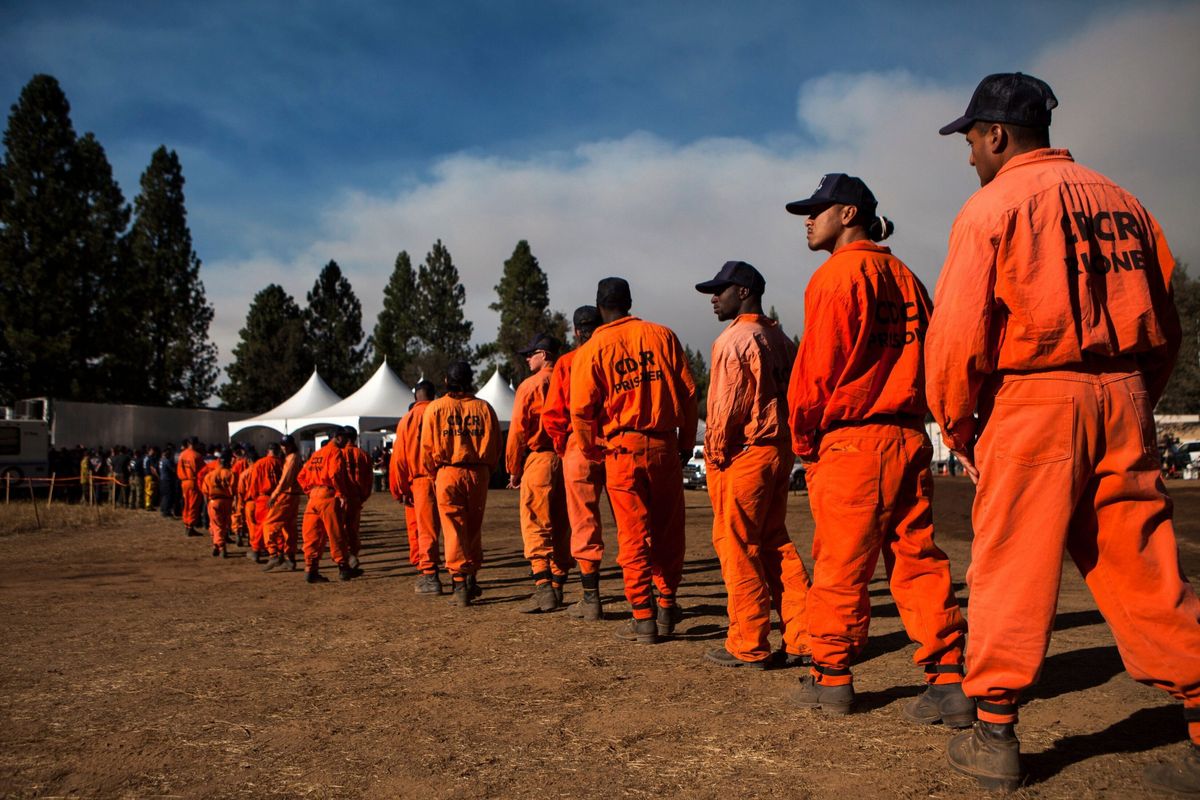There is a striking racial disparity in US crime statistics. The reasons are complex

A few minutes every morning is all you need.
Stay up to date on the world's Headlines and Human Stories. It's fun, it's factual, it's fluff-free.
Statistics alone tell an incomplete story. To understand them in their entirety, one must also consider the justice system and societal factors in which those numbers exist.
“There are three kinds of lies: lies, damned lies, and statistics.” That phrase, made famous by American author Mark Twain, is a pithy way of saying that statistics without context can easily be used to misrepresent reality. On the surface, statistics might seem impervious to human bias (it’s math, after all), but numbers that lack background information are almost meaningless.
Among the most contentious and debated statistics are those for crime rates in the United States. When reviewed on their own, they reveal a troubling reality: people of color, particularly Black people, are far more likely than white people to be arrested and convicted of crimes. That reality, which few people dispute, invites biased interpretation and is frequently the basis for white supremacist talking points.
However, the statistics alone tell an incomplete story. To understand them in their entirety, one must also consider the justice system and societal factors in which those numbers exist.
US crime statistics
As crime statistics can be confusing, especially as differing sources can seem to contradict each other, TMS spoke with Leonard Sipes. Sipes is a retired senior public affairs specialist for the federal government and the creator of CrimeinAmerica.net. He is also a former senior specialist for crime prevention for the Department of Justice’s (DOJ) clearinghouse and director of information management for the National Crime Prevention Council.
Sipes recently published an analysis of a report by the Bureau of Justice Statistics (BJS), a division of the DOJ responsible for collecting and reporting crime statistics in the US. That report, published in January 2021, is entitled “Race and Ethnicity of Violent Crime Offenders and Arrestees, 2018” and was written by Senior Statistical Advisor Allen J. Beck.
The report “compares the FBI’s Uniform Crime Reporting (UCR) Program data on incidents of nonfatal violent crime to data from BJS’s National Crime Victimization Survey (NCVS) to determine if arrest differences by race and ethnicity can be attributed to differences in criminal involvement.”
As Sipes explains, “There are two principal methods of collecting data on crime in the United States, crimes reported to law enforcement from the FBI and the National Crime Victimization Survey from the Bureau Of Justice Statistics based on a census-like national survey to get an approximate count of all crime.”
Since this BJS report focuses on victim responses, the information pertains specifically to nonfatal crimes, not murders or incidences of manslaughter. Or, as Sipes puts it, “you can’t interview dead people in [the] National Crime Victimization Survey, thus homicides are excluded.”
The report finds that, based on their proportion of the population, both Black people (roughly 13% of the population) and Hispanic people (roughly 18%) are overrepresented in arrests for violent crimes. Meanwhile, white people, who make up 60% of the nation’s population, were underrepresented in arrests for rape, robbery, aggravated assault and other forms of assault.
Yet, according to arresting records, the report states, “White and black people were arrested proportionate to their involvement in serious nonfatal violent crime and proportionate to their involvement in serious nonfatal violent crime reported to police.”
In other words, there was no clear racial bias in arrests for violent nonfatal crimes when compared to the racial makeup of suspects as identified by the victims.
Racial bias and racism
Sipes says that his reporting on those statistics has resulted in a backlash and accusations of racism. At face value, these statistics appear to support the white supremacist narrative that Black people are inherently more prone to criminality than white people. That interpretation, however, only works if all context is ignored.
Sipes acknowledges that those within the justice system have a duty to “rededicate ourselves to equal treatment” and that addressing violent crime requires trust between law enforcement and communities of color.
“Violent crime is like COVID,” he says, “it destroys everything it touches, including economic development, jobs, education, and the mental health of residents. It can only be fought through consensus. It can’t be imposed. Developing that consensus is the primary criminological issue facing us right now.”
It is the malleability of statistics to fit a predetermined narrative that white supremacists exploit when they use memes like “13/50” (sometimes rendered as “13/52” or “13/90”) in social media replies. The numbers are a reference to a 2018 FBI report that appears to prove that Black people commit a little over 50% of the murders in the US, despite only accounting for 13% of the population.
There are multiple issues with the meme, starting with the fact that the data refers to arrests, not to total crimes committed or even convictions. Additionally, as noted in the report’s small print, the surveyed policing agencies were not required to report on the ethnicity of their arrestees, meaning the information is inherently incomplete.
To get into a debate over the percentages, however, is a trap. It is an undeniable truth that in the US, when considering population size, Black Americans are charged with and convicted of crimes at a disproportionate rate compared to any other ethnic group. The more important question is why that is the case.
A courtroom perspective
US crime statistics can only give a partial picture of the justice system. For a broader perspective, TMS reached out to defense lawyers who were able to provide more nuanced insights derived from their years of experience in courtrooms and around the justice system.
Brian D. Joslyn is a Columbus, Ohio-based criminal defense attorney and the principal attorney at Joslyn Law Firm. Joslyn says his years in the courtroom has made the racial bias in the justice system readily apparent, particularly as it relates to drug offenses. Police reports of drug arrests, he says, often reveal suspicious justifications for searching a vehicle. Inevitably, the defendant is Black.
Anecdotal evidence is no more concrete than contextless statistics, though, so Joslyn and his firm took a deeper dive into the numbers.
Joslyn’s firm analyzed a report on drug arrests assembled by the American Civil Liberties Union. Their analysis determined, “Across the 50 states, on average, Black people are 3.6 times more likely to be arrested on marijuana charges. This racial disparity has continued to grow over the years as racial profiling among law enforcement has become an increasingly apparent issue.”
In the Georgia county of Pickens, the Black arrest rate was “97.3 times higher than the white arrest rate.” This was despite white people making up 96% of the county’s population. Elsewhere, Montana had the largest state disparity, with Black people being “9.6 times more likely to be arrested for marijuana possession.” Racial disparities in arrests weren’t rare, the analysis determined.
“What’s also interesting,” Joslyn adds, “is how this trend isn’t isolated to one region of the country or another. As an example, relatively progressive regions like Illinois and New York are on the list many times. Equally, relatively conservative southern states are on there too. So, it impacts most regions where marijuana is still illegal (or their decriminalization laws aren’t followed appropriately).”
What is the solution to this disparity in arrest rates? Joslyn has an answer: “Police departments need to have an overhaul that strictly instructs and trains their officers to only pull motorists over for well-established violations of law and not fishing probes or profiling. They also need a refresher course in the 4th Amendment (unreasonable searches and seizures).”
Joslyn also supports the decriminalization of marijuana on a federal level and the end of the so-called “War on Drugs,” which he calls a failure.
A history of inequality
Brian Dunn, the managing partner of the Cochran Firm California, the Los Angeles based office of founder Johnnie Cochran, Jr., similarly believes the racial divide in the justice system has been exacerbated by the anti-drug policies of President Ronald Reagan and subsequent administrations.
Yet, as Dunn explained to TMS, that’s just one facet of systemic inequality, which began with slavery and continued on through the 1994 crime bill and the related “three strike” laws.
It is a topic covered at length in Ava DuVernay’s 2016 documentary “13th,” which explores racial inequality in the US since the formal end of slavery in 1865. The 13th Amendment allows for a loophole in abolition: slavery is outlawed “except as a punishment for crime whereof the party shall have been duly convicted.”
It is that loophole, both DuVernay’s documentary and Dunn argue, that the justice system has exploited ever since to arrest Black people at a disproportionate level.
Dunn is unambiguous about what he believes is the single biggest factor leading to this disparity: “The way that crimes are charged in the United States.”
The same crime, he explains, can result in a different outcome at the point of arrest, charging, conviction and sentencing, depending on multiple factors, including the identities of the victim and the suspect.
“There are no hard and fast formulas that apply equally,” Dunn states. So, even if arrests are equitable, as the BJS report on violent nonfatal crimes found, the outcomes may not be.
As an example, Dunn says to imagine a bar fight in which one person physically harms another. There are countless ways the crime could be charged depending on a variety of factors, from the severity of the injuries to whether a weapon was involved, even whether someone said something threatening during the fight.
The result could be a successful self-defense plea or a sentence of life in prison, or something in between. In Dunn’s experience, a person’s skin color is consistently a factor in these outcomes. With so much subjectivity in the process, from the arresting officer all the way up to the judge, Dunn contends there are countless areas for bias – implicit or explicit – to enter the equation.
At the root of this bias, Dunn asserts, is a historical belief that Black people (Black men, specifically) are less than human, even monstrous and sexually deviant. Slavery, the post-Civil War black codes, Jim Crow laws and, now, disproportionate arrests of Black people, fall on a continuum: “a system for dehumanizing a large segment of society.”
Skeptics might argue criminal defense lawyers are primed to see racism because of their clients. That wouldn’t explain, however, a 2020 survey of US judges which found that 65% believe “racism is systemic in the United States’ criminal justice system.”
As one respondent to the survey said, “Most of the judges I know are not overtly racist and sincerely seek to treat all people equally, but I suspect that our implicit biases impact our decision-making more than we realize.”
The crime of poverty
The debate over racism in the criminal justice system has birthed the “Defund the police” movement, which gained traction last summer amid the Black Lives Matter protests. Calls for police reforms often start with the addressing of bias, both overt and implicit.
A survey last summer found that Americans are divided over whether they believe police officers treat white people better than Black people. The divide was mostly down political lines, with Democrats far more likely than Republicans to say policing in America is plagued by racial bias. Among Black Americans, there is hope the Biden administration will address this issue, but it’s a tempered hope.
For Reverend Dr. Kelly Brown Douglas, though, the issue is also societal. Rev. Douglas is the Canon Theologian at the Washington National Cathedral and the Dean of Episcopal Divinity School at Union Theological Seminary in New York City.
“The single biggest factor that leads to disproportionate crimes rates among Black Americans,” Douglas says, “is poverty. Black Americans are more than two times as likely to be trapped in poverty than white Americans and at a rate higher than the Latinx and Asian Community. Moreover, more than one-quarter of Black American children live in poverty, which is at least three times the rate of white children.”
Poverty, Douglas explains, is a condition with many related symptoms: it leads to “the lack of decent educational, employment, recreational and overall life-enhancing opportunities.”
When in office, former President Donald Trump was fond of saying he was the “best president” for Black Americans, touting record low unemployment numbers. And, in fact, in 2019, Black and Hispanic Americans achieved historically low levels of poverty.
It is a statistic to be celebrated, but one that, yet again, needs to be considered in a broader context. Though 2019 saw poverty hit historic lows in the Black community, that low was 18.8% (15.7% for Hispanic Americans). In comparison, the poverty rate for white Americans (and Asian Americans) was 7.3%.
In the early-1970s, more than 30% of Black Americans were in poverty, while white Americans were at roughly 7%. There are two ways to look at that data. One is to acknowledge the progress Black Americans have made in the past half century. The other, though, is to recognize how far Black Americans have had to come to still face poverty levels at more than double their white counterparts.
“It should be no surprise,” Douglas says, “that one would see a disproportionate rate of crime. As poverty limits opportunities, it limits life-enhancing choices. Hence, the root crime is poverty itself. It is a crime that breeds crime. Black crime rates are symptomatic of poverty. It is not until we see poverty as a criminal offense that we will be able to decrease the Black American ‘crime rate.’”
Douglas concludes, “Inasmuch as Black people are disproportionately victimized by the crime of poverty, Black America will have a disproportionately high crime rate. Simply put, if one is to decrease the crime rate in the Black American community, Black people must be freed from the criminal cycle that is poverty.”
Have a tip or story? Get in touch with our reporters at tips@themilsource.com




Comments ()